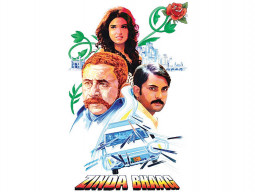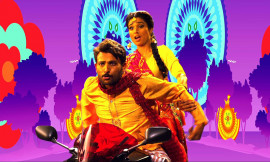
When asked about the movie, co-director Meenu Gaur said, “We wanted to make a movie that we ourselves would like to go and watch in the theatre.” Zinda Bhaag is a very distinct film that employs cinema verite along with Lollywood kitsch to create a strong narrative that is both entertaining and conscientious. It is a Punjabi film that takes pride in its heritage without compromising its integrity. With Zinda Bhaag, the Pakistani film industry embarks on its nouvelle vague while setting an entirely new standard for South Asian cinema. It is the quintessential representation of the existential crisis facing young Pakistanis. However, most importantly, the film addresses the dwindling middle class and the working poor. The film recounts the story of three friends trying to get out of Pakistan as narrated by Naseeruddin Shah’s character Pehlwan, who happens to be the area godfather. In a country where gambling is prohibited by law but still quite rampant, young men are willing to gamble with their own lives in order to realise their ‘American Dream’. Zinda Bhaag is a cautionary tale that somehow avoids being preachy.
Pakistani cinema has revived due to the lifting of restrictions against Indian films. As film is one of the most collaborative forms of art, without cross-border cooperation, nothing would have been possible. Art house cinema actor Naseeruddin Shah invested in the industry with his participation in several hit films. With his patronage and performance in Zinda Bhaag, the industry is indebted to Shah.
Farjad and Meenu derive stellar performances. Amna Ilyas plays the true ‘hero’ Rubina — a young, ambitious woman trying to earn an honest living in a corrupt nation. She sees the potential in Khaldi (played flawlessly by Khurram Patras) and tries to help him. In a brilliant tete-a-tete, which involves proverbs, hilarious Punjabi sayings and play on words, the entire structure of their relationship is revealed. The filmmakers pay a tribute to the industry by offering Naghma Begum the memorable role of a selfish mother pushing her children’s buttons while consuming trash television.
Sahir Ali Bhagga’s music is an essential element in the construction of the ebbs and flows in the film. Every song is deliberately woven and moves the narrative while layering it. How would the Oscar voters understand the foreshadowing of events and the multiple associations of “Par Chana De” where the conversation between Sohni and her ghara (clay pot) are not translatable? Punjabis, however, will be delightfully reintroduced to the kinship between cinema and literature, and enjoy the language of cinema once again.
Zinda Bhaag is the most beautiful and complex film to come from Pakistan in decades and proves that great storytelling does not need massive budgets or a Bollywood repertoire. This year Zinda Bhaag will run for a spot on the Oscar shortlist with the likes of other remarkable films like Omar, La Passe, Child’s Pose, Cannibal, and Gloria. However, in the hearts of Pakistanis everywhere, when they see Zinda Bhaag, they already know it’s a winner.
Published in The Express Tribune, October 1st, 2013.
Like Opinion & Editorial on Facebook, follow @ETOpEd on Twitter to receive all updates on all our daily pieces.
COMMENTS (13)
Comments are moderated and generally will be posted if they are on-topic and not abusive.
For more information, please see our Comments FAQ





















1714119118-0/image-(7)1714119118-0-270x192.webp)








1714024018-0/ModiLara-(1)1714024018-0-270x192.webp)









All (non-Lollywood) Pakistani films coming out are getting rave reviews in the local press. And frankly none of them have been half decent. I guess Pakistani's are too excited to see films set in Pakistan to pay attention to the quality of cinema.
'It is impossible for its nuance, humour and wit to be translated into English', then why make a film which is essentially a visual medium. If you can't cinematically communicate your idea which holds the film together, then you have failed. Zinda Bhaag is structurally confused; neorealism meets Bollywood (or lip-syncing musical?). The story's major flaw is lack of a proper inciting incident - word is that funding came from Germany, perhaps to better understand and create empathy for the influx of illegals coming in. Well that's not happening because characters have weak motivations for most of their actions and things just happen.
It's low budget and it looks low budget so direction takes a hit there. Though well acted with average cinematography and decent edition. There are many good movies about immigration (legal and illegal), this unfortunately is not one of them.
German propaganda machine churned out excellent movies during the 30s and during the great war.
So does today's Iran.
Churning out movies do not mean anything unless its backed by a free society which is willing to discuss and question and even offend!
Me too I saw it and all times the shows were full or almost full. The film had such few shows here compared to that horrible film with Shahid Kapoor and yet it did better than that film. As far as I can tell thats amazing!
@Blunt: Can I ask what show u saw ?? Cuz i saw 7:50 eve show at Atrium on opening day with my family and it was almost full and it got standing ovation from the audience.
By the way, this article is indeed refreshing and beautifully written. I have to disagree with one point. While it might be fashionable to pooh pooh Bollywood flicks among the educated elite, those Bollywood so-called 'masala' movies remain ever popular both sides of the border among the masses. There's a genuine reason for that: Bollywood movies are indeed ENTERTAINING. That's why while Zinda Bhaag might be a contender for Oscars, most cinemas in Pakistan will replace "Zinda Bhaag' with Bollywood's romantic comedy "Besharam" tomorrow when it officially gets released in Pakistan. That's despite the fact that Zinda Bhaag has not even been in cinemas for two weeks yet and it was not even released in most and especially single-screen cinemas in Pakistan in the first place because those cinemas were showing "Phata Poster Nikla Hero." That's because the majority of Pakistani cinemas indeed DO NOT release local art movies like this one because Bollywood flicks have greater entertainment value as seen by the cinema-going masses.
So the only way Lollywood or Pakistani cinema can take off is by trying to offer Bollywood-style masala comedies and musicals with at least one item number. Zia-induced prudery must end. If Pakistani movie-makers just keep appeasing the fundamentalists and avoid showing skin and good dance performances in their movies then they should not complain that Bollywood movies keep doing all the business in Pakistan and no one in Pakistan gives hoot to their Pakistani movies. Of course, good scripts, great acting and nice songs and music are also needed to make a Bollyood-style great movie but "art" Pakistani movies like the recent flops "Lamha/Seedlings" and "Josh" can NEVER even dream to capture the attention of Pakistani cinemas audiences, who would much rather watch Bollywood movies.
"Zinda Bhaag is the most beautiful and complex film to come from Pakistan in decades."
That's high praise indeed. And even though I can't understand Punjabi, I can at least appreciate the music because because good music is universal. Speaking of universality, hope this movie gets released internationally. And in India too since Bollywood movies are shown all over Pk in the cinemas and are quite the rage here too.
@Blunt: i saw it last week at DHA Lahore and the cinema was packed. Good quality movie - kudos to all involved. I thought it may not do phenomenally well at the box because it's essential message is pessimistic and not the usual uplifting happy ending.
@LaLaki just chill chill just chill and stop trolling Pakistani web sites!
Simply the BEST pakistani film EVER. I have watched in 3 times already.
Zinda Bhaag is an over rated and over hyped movie...A good one time watch...not so sure if it is oscar worthy though... I watched Zinda Bhaag on opening day at atrium and there were hardly about 50 people watching it out of capacity of 400 seats...
"the kinship between cinema and literature".... I think this where pakistani cinema was lacking. Now after seeing the recent and upcoming string of pakistani movies like Chambaili, MHSA, ZInda Bhaag, WAAR, Operation 021, Swaarangi, Siyah, Lamha it looks like pakistani film industry finally realized what to address in a movie.
"that great storytelling does not need massive budgets or a Bollywood repertoire"....eaxctly this is what i want to say above.
"However, in the hearts of Pakistanis everywhere, when they see Zinda Bhaag, they already know it’s a winner"....yup you are right author. This movie is already a winner for us.
Zinda Bhaag will not win the Oscar. Not because it is not good enough, but because it is impossible for its nuance, humour and wit to be translated into English. The very thing that will make it a sensation in Pakistan and India will work against it at the Academy:
Firstly..India has nothing to do with this films..this movie ...even will not be able to earn 10,000 indian rs in india..........nobody has seen a promo or anything of this film in india....so just chill...................and i dont know why have u put india in discussion...u say anything indian is not accepted in oscar......so according to u.......Slumdog millionaires and life of Pii....were in pakistani diaspora i think...there singers were pakistani's....actors were pakistani..congratulations to all pakistanis who acted in such a film......and Please i am saying again and again our competition is with brazil and china....not somalia,yemen,sudan or pakistan...........
Refreshing write up!